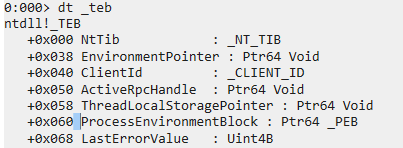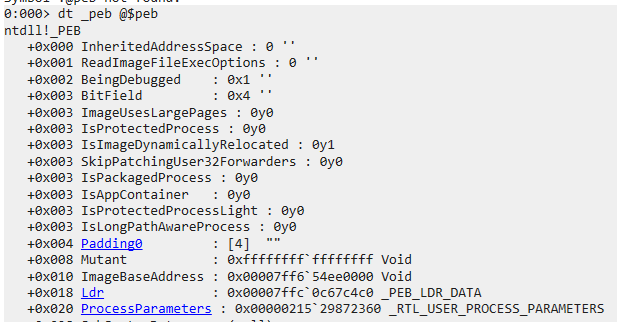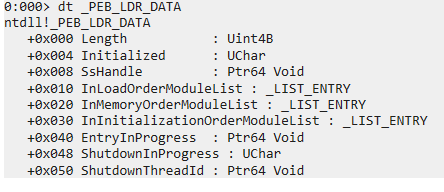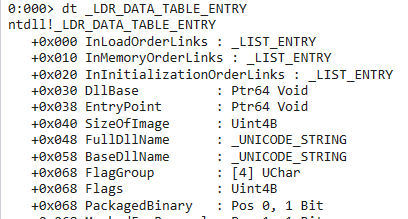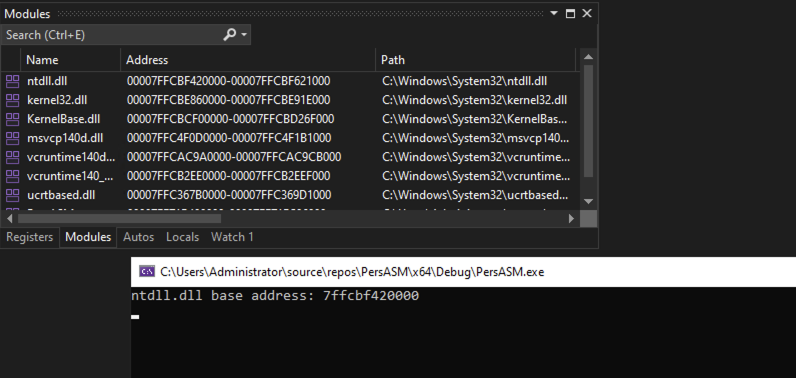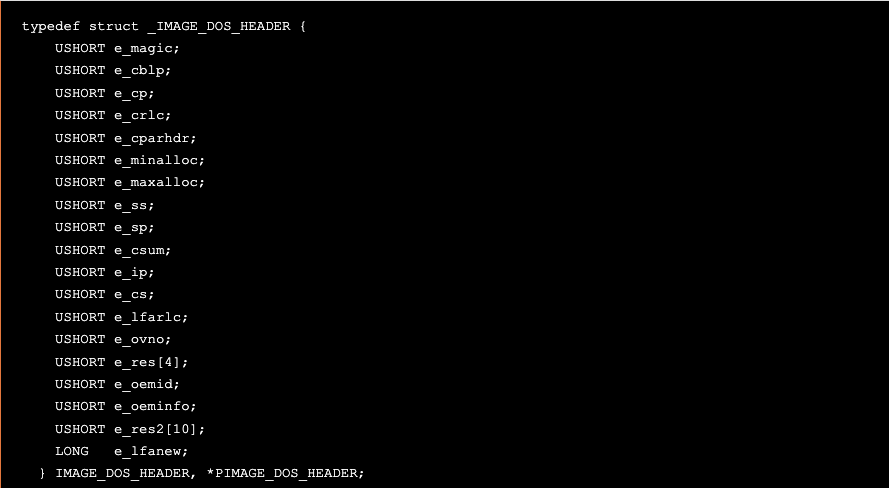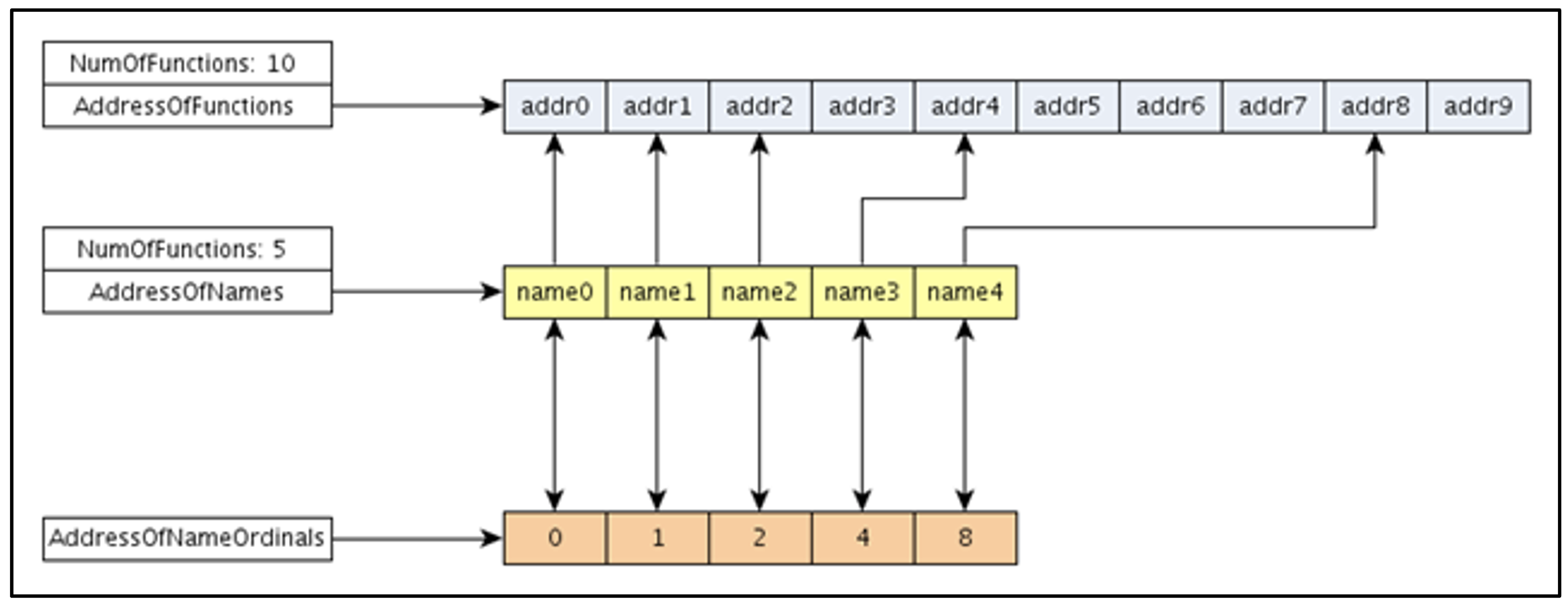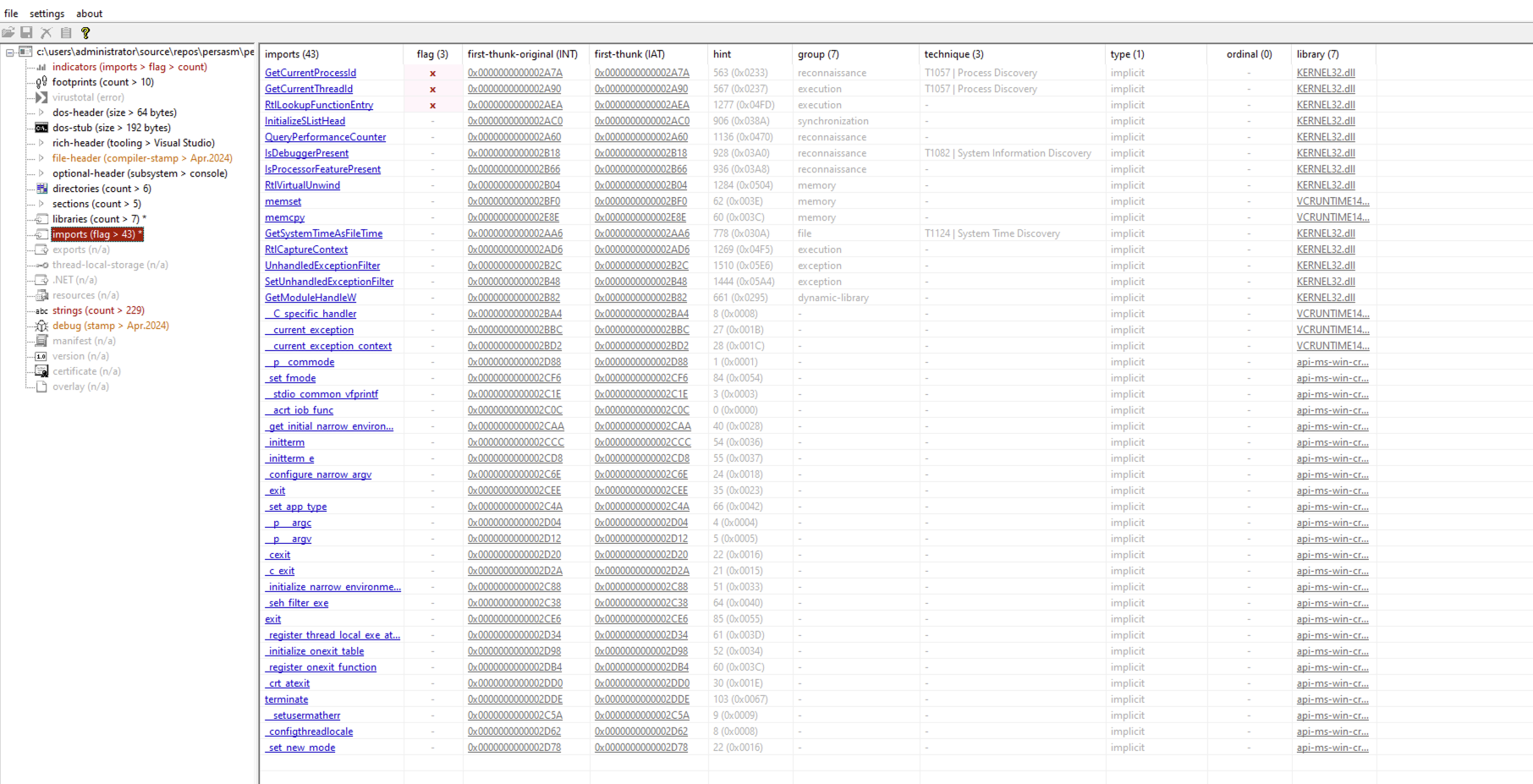Flying Under the Radar: Part 1: Resolving Sensitive Windows Functions with x64 Assembly
John Stigerwalt released a post on LinkedIn which highlighted the use of assembly to retrieve Windows functions via the PEB. This naturally interested me, led to me messing with assembly and eventually led to me writing this blog. Talking about some of his research and shared content seemed like a good place to start the blog series.
Part 1 of this series will discuss a common malware development problem that affects the bypassing of both Static Detections and Dynamic Detections when working with Windows Portable Executable (PE) files. The accessing of sensitive Windows Native API functions.
Disclaimer:
I am by no means an expert in any of the below areas, and I shall describe things as per my understanding of them. I do not condone nor encourage these materials or shared knowledge to be used for any form of illegal or unethical activity. This blog is aimed at spreading knowledge about malware development techniques to security professionals.
GitLab Project for Flying Under the Radar - Part 1
You can find all the code used within this blog here
Standing on the Shoulders of Giants - Credits & References:
The content of this post owes much to the invaluable knowledge generously shared by the following individuals and the materials they have authored. Their work serves as a significant reference point, and I look up to these individuals.
Contents
- The Problem
- Resolving Modules and their Functions with x64 MASM Assembly
- Compilers and Resulting IAT Entries
- Conclusion
The Problem
Function resolving can be problematic for malware developers. This can be split into a set of smaller problems.
Problem #1 - Pre-execution: Static Analysis and Sandbox Environments
Amongst malware developers there is a common desire to reduce the entries in a PE’s Import Address Table (IAT). The IAT provides defenders and defensive tooling an idea of what native functions a PE is calling and therefore it allows for deductions on what the PE might be doing before it is even executed. Consequently, keeping the IAT entries minimal or rather keeping suspicious Windows Native API imports out of IAT is highly desirable for malware developers.
Furthermore, often if a particular defensive security tool is uncertain of a PE following a static analysis pass, a PE may be subject to a minimal form of Dynamic Analysis in a virtual environment such as a Sandbox. This could be an attempt to confirm any suspicions raised during the Static Analysis scan. Really this is a form of Dynamic Analysis but I thought it would be more appropriate here as I consider it part of the pre-execution phase and directly dependent on Static Analysis. Local sandboxed execution is suspected to also only be performed for a very short time to avoid decreased user experiences, but in-depth Dynamic Analysis could be performed thereafter in the security vendor’s cloud container.
Problem #2 - Post Execution: Dynamic Analysis
If it is possible to get to the stage of PE execution, after a PE successfully passes any Static Analysis scrutiny and/or temporary Sandbox Environments, the main problem will be facing something like an EDR.
Many EDR products exist and they all function in different ways, it is my opinion that they perform some of the following:
- User Behavioural Analysis - e.g does the user typically perform this action or have they ever?
- Usermode Windows Function Monitoring - e.g EDR function hooking
- Call Stack Analysis - Checking the origin of function calls via the Call Stack chain
- Process Analysis - e.g memory region analysis, remote process access, child processes, etc
- Kernel Callbacks - Kernelmode notifications and/or registration system that allows for some kernel drivers (e.g EDRs) to be informed of the execution of a system function
If we were to consider function hooking specifically, directly accessing and calling specific Windows Native API functions is known to trigger an EDR. Therefore, resolving access to Windows Native API functions during the PE’s runtime is seen as desirable for malware developers.
Existing Solutions
To address both these problems malware developers have leverage usage of two common kernel32.dll functions - GetProcAddress and GetModuleHandle. Or have perhaps opted to use direct or indirect syscalls (which comes with its own set of challenges) and depending on the code implementations may still result in a PE file having multiple suspicious imports in IAT. Having the ability to stealthily resolve functions on a given Windows system (whether for usage, hook inspection, or to setup an direct/indirect syscalls) is highly beneficial to a threat actor.
Lets review GetProcAddress and GetModuleHandle:
- GetProcAddress - allows for the resolving of a process loaded DLL’s base address
- GetModuleHandle - allows for the resolving of a function address based on a DLL’s base address
These can be called directly which would result in entries for at least both these functions in IAT (an probably an EDR detection if you ever made it to the execution phase). Or more commonly, malware developers have implemented their own custom versions of these functions in their preferred programming language.
Having used C++ or C# custom implementations of these functions, I noticed that the usage of imported Windows functions accumulated and made for a lengthy IAT entries table. When implementing your own versions of GetProcAddress and GetModuleHandle in C++ or C# to resolve either kernel32.dll or ntdll.dll functions, you cannot really reduce the existing IAT entries as you are trying to achieve the very functionality you need, which is a bit of a chicken and egg problem. While some existing IAT entries may not be “suspicious” as such, I want to explore opportunities that result in a “leaner” PE IAT entries table.
So let’s explore some ideas to try and achieve stealthy Native API Windows function resolves, so that we may later inspect them, modify them, or use them to set up a direct/indirect syscall. While setting up direct/indirect syscalls won’t be part of this initial blog, it may be covered in subsequent posts of the Flying Under the Radar series.
Note: If you are not familiar with low-level programming, I strongly recommend you read about String Length, Comparisons and Obfuscation in x64 MASM Assembly and generally become more familiar with other concepts present in the Knowledge Primer to get the most out of my content - it will be updated over the course of the blog series.
Resolving Modules and their Functions with x64 MASM Assembly
Resolving Windows functions requires that we have a DLL base address from which we want to search for functions. So lets start by retrieving a given process loaded DLL base address with assembly.
Lets cover the main steps of resolving a given Windows DLL base address with assembly:
- Access to a given Windows process loaded DLL’s base address e.g ntdll.dll
- Access to PEB via TEB
- Access to
PEB->Ldr - Access to
PEB->Ldr->InLoadOrderModuleList(double-linked list) - Traverse linked list and find target DLL by name string comparison
- Accessing the target process loaded DLL’s base address and returning from the assembly function
Accessing a process loaded DLL in x64 assembly via the Process Environment Block (PEB)
Let us try an resolve ntdll.dll from the current process.
In x64 Windows systems, the GS register points directly to the Thread Environment Block (TEB) for the current thread, which contains a pointer to the Process Environment Block (PEB). The PEB contains various information about a process, such as process parameters, environment variables, and loaded modules. In x86 Windows systems the same is true for the FS segment register.
From the above screenshot, if we were to inspect the TEB structure in Windbg we can see that the PEB is at offset 0x60. Therefore, since the GS segment register already points to the current process’s TEB we can simply point to offset 0x60 in the GS register to access the value at that location - in this case the address of PEB.
Looking at the PEB structure we can see that the offset to Ldr is at 0x18. In the Process Environment Block (PEB), Ldr points to a PEB_LDR_DATA structure. This structure is used to manage loaded modules (such as DLLs) in the current process. It includes information about loaded modules, most importantly, their base addresses and name.
The PEB_LDR_DATA structure looks like this:
We are most interested in InLoadOrderModuleList which points to a double linked list. The linked list allows us to navigate between the LDR_DATA_TABLE_ENTRY structures that contain loaded module information.
The LDR_DATA_TABLE_ENTRY structure looks like so:
Within LDR_DATA_TABLE_ENTRY we can see the dllBase at offset 0x30 and the baseDllname (DLL name) at offset 0x58. Note as we are traversing the loaded module linked list, our “default” position/offset in each accessed linked list LDR_DATA_TABLE_ENTRY struct entry will be at 0x10 (InMemoryOrderLinks).
Now that the basics of what we are trying to achieve are covered, we can implement assembly code.
Example x64 MASM assembly to resolve the ntdll.dll base address can be represented as such:
1
2
3
4
5
6
7
8
9
10
11
12
13
14
15
16
17
18
19
20
GetNtdllBase proc
; Load the address of PEB into RAX via GS segment
xor rax, rax
mov rax, gs:[60h]
; Navigating PEB->Ldr->InLoadOrderModuleList
mov rax, [rax + 18h] ; Offset of PEB->Ldr in PE
mov rax, [rax + 20h] ; Offset of Ldr->InLoadOrderModuleList
; Ldr->InLoadOrderModuleList points to the first LDR_DATA_TABLE_ENTRY structure in the linked list
; We are currently at linked list node 0 (PE itself) so we can dereference once to get to node 1 (ntdll.dll)
mov rax, [rax]
; Since we are in LDR_DATA_TABLE_ENTRY and already at offset 0x10 (InMemoryOrderLinks)
; We add 0x20 to access the dllBase address (offset 0x30) value by dereferencing
mov rax, [rax + 20h]
; We now have NTDLL.DLL base address in rax which we can return
; or use for further assembly operations
ret
GetNtdllBase endp
We can test the above GetNtdllBase assembly function with some C++ code in a MASM enabled VS project:
1
2
3
4
5
6
7
8
9
10
11
12
13
14
15
16
17
18
19
#include <Windows.h>
#include <stdio.h>
// Assembly function declarations
extern "C" DWORD_PTR GetNtdllBase();
int main() {
// resolve ntdll.dll base address
DWORD_PTR TargetAddr=0;
TargetAddr = (DWORD_PTR)GetNtdllBase();
if (TargetAddr) {
printf("ntdll.dll base address (Assembly DLL resolve via PEB): 0x%p \n", TargetAddr);
} else {
printf("Failed to get %s base address \n", dllName);
return 1;
}
getchar(); // effectively pause EXE by getting user input
return 0;
}
Now that the basics of getting access to process loaded DLL bases addresses are covered, we can build on the assembly so that it allows us to resolve the base address of ANY process loaded DLL. The easiest way to do that, would be to search LDR_DATA_TABLE_ENTRY entries the InLoadOrderModuleList linked list for DllBaseName (offset 0x58) values that match the DLL name we wish to resolve.
As a simple demonstration, it is possible to navigate through the linked list modules in x64 MASM assembly, by dereferencing the rax register like so:
1
2
3
4
5
6
7
8
9
10
11
12
13
14
15
...
; Load the address of PEB into RAX via GS segment
xor rax, rax
mov rax, gs:[60h]
; Navigating PEB->Ldr->InLoadOrderModuleList
mov rax, [rax + 18h] ; Offset of PEB->Ldr in PE
mov rax, [rax + 20h] ; Offset of Ldr->InLoadOrderModuleList
; Ldr->InLoadOrderModuleList points to the first LDR_DATA_TABLE_ENTRY structure in the linked list
; currently linked list head points to PE itself LDR_DATA_TABLE_ENTRY struct
mov rax, [rax] ; move to next linked list node [1] e.g typically ntdll.dll LDR_DATA_TABLE_ENTRY struct
mov rax, [rax] ; move to next linked list node [2] e.g typically kernel32.dll LDR_DATA_TABLE_ENTRY struct
; etc
...
You can get a rough idea of the DllBaseName structure here: 
Once you access the DllBaseName struct you will find its Length at offset 0x00 and its content buffer at 0x8. Keep in mind that the buffer points to the base address of a character array, each character being separated by a null byte.
At a high level this would look like this in x64 MASM assembly:
1
2
3
4
5
6
7
8
9
10
11
12
13
14
15
16
17
18
19
20
21
22
23
24
25
26
27
28
...
; We are in a given module LDR_DATA_TABLE_ENTRY struct from the module linked list..
; default location is offset +0x10 in current LDR_DATA_TABLE_ENTRY struct
; DllBaseName should be at 0x58-0x10 (offset 0x48)
; DllBaseName struct has Length attribute at 0x00, therefore at [rax + 48h]
; Divide length by 2 to account for null byte separators
xor rdx, rdx
mov dx, word ptr [rax + 48h] ; length of module name
; length of string with every char succeeded by a NULL byte so twice the length of characters
; we therefore need to divide the length by 2, to get the number of characters
shr rdx, 1
; Compare current module baseDLLName with target dllName length
cmp rdx, r13
; if length not equal move to next item
jnz module_loop
; if equal move to byte-by-byte comparison of the two strings
; Compare each byte in current module DllBaseName string with our target dllName string
; If strings match, find the base address of current module
; prep for string comparison function call
; rbx contains module string length
mov rcx, [rax + 48h + 8h] ; access current module string pointer as arg1
mov rdx, r12 ; target module name as arg2
mov r8, r13 ; length as arg3
...
Note: You can find a full custom x64 assembly implementation of
GetProcAddressand its supporting C++ code here
Finding a function address in a the process loaded DLL in x64 assembly
Sticking with above example, we will also focus this section on ntdll.dll and resolving an arbitrary function address - in this case we will use NtDelayExecution.
At a high level - in order to resolve a function address from a process loaded DLL, the most important requirements are a base address to the DLL we wish to access and the name of the function we want to resolve. To be consistent with the section above, we shall use ntdll.dll as the DLL and NtDelayExecution as the function we wish to resolve.
The overall function resolving process will look like so:
- Getting access to the PE Header, Export Table, and Names Table from the process loaded module/DLL base address
- PE Header:
DOS->e_lfanew+ module base address - Export Table: PE Header + offset to
DataDirectory(total offset 0x88) - Names Table: Export Table address +
AddressOfNamesoffset (0x20) - Ordinal Names Table: Export Table address +
AddressOfOrdinalNamesoffset (0x24) - Function Address Table: Export Table address +
AddressOfFunctionsoffset (0x1C)
- PE Header:
- Start by iterating through the
AddressOfNamesentries- Perform string comparisons to find our desired function name
- Save
AddressOfNamesarray index on match
- Lookup the stored
AddressOfNamesarray index in theAddressOfNameOrdinalsarray- Save ordinal value at that
AddressOfNameOrdinalsarray index
- Save ordinal value at that
- Based on the saved function ordinal, access
AddressOfFunctionsarray at using the ordinal as the index- Retrieve the function address
- Return function address
In order to access the PE Header we need to add the value pointed by ofDOS->e_lfanew to the module base address. DOS->e_lfanew is the offset to the PE Header and is defined within the IMAGE_DOS_HEADER struct.
The PE Header is defined in a IMAGE_NT_HEADER64 struct which can be seen below. Now that we have the PE Header, we want to access the IMAGE_EXPORT_DIRECTORY struct. To resolve it, we need to add DataDirectory at offset 0x88 (OptionalHeader offset + DataDirectory offset) to our PE Header address:
Now that we have the address of the Export Table, we need to pinpoint 3 other key tables nested within that will allow us to perform our function lookup:
AddressOfNames- Names TableAddressOfOrdinalNames- Ordinal Names TableAddressOfFunctions- Function Address Table
We see the 3 key tables are all contained in the Export Table represented as a IMAGE_EXPORT_DIRECTORY struct (shown below). 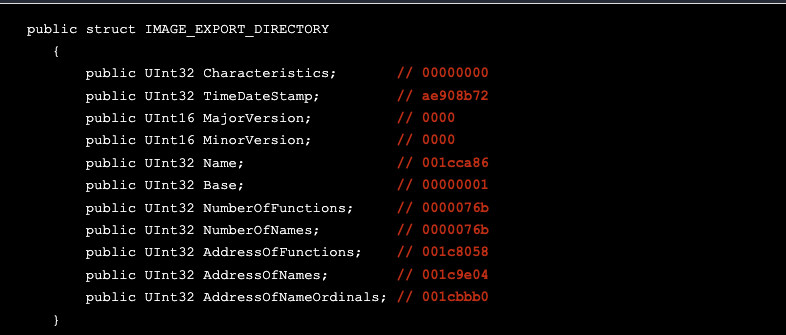
Let’s discuss the interdependance of the AddressOfNames, AddressOfOrdinalNames and AddressOfFunctions tables and how one should navigate them to resolve a desired function address.
- Iterate the
AddressOfNamesarray fromi=0toi=(NumberOfNames-1), comparingAddressOfNames[i]with the stringname3. - Once we have a match in the
iposition, the loader will refer toAddressOfNameOrdinals[i]and get the ordinal associated to this function. Let’s suppose thatAddressOfNameOrdinals[i] = 4. - Having the
ordinal = 4, the loader will now refer toAddressOfFunctionson 4th position, that isAddressOfFunctions[4], to finally get the RVA associated to thename3function.
We can retrieve and use the above mentioned tables like so in x64 MASM assembly:
1
2
3
4
5
6
7
8
9
10
11
12
13
14
15
16
17
18
19
20
21
22
23
24
25
26
27
28
29
30
31
32
33
34
35
36
37
38
...
; set functionName rcx (arg1) to r9 as pointer
mov r9, rcx
; set length of string rdx (arg2) to r13 (value?)
mov r13, rdx
; pass r8 (arg3) which has module base address into r11
mov r11, r8
; pass PE HEADER to resolve export table for function symbol search
xor r8, r8 ; Clear R8
mov r8d, dword ptr [r11 + 3Ch]
mov rdx, r8 ; Move DOS->e_lfanew to RDX
add rdx, r11 ; Calculate PE Header address + base address
; rdx should now point to PE header
mov r8d, dword ptr [rdx + 88h] ; Calculate offset to the export table (OptionalHeader (0x18) + DataDirectory (0x70) offsets)
add r8, r11 ; Update R8 to point to the export table
; r8 should now point to Export Table
sub rsi, rsi ; Clear RSI
mov esi, dword ptr [r8 + 20h] ; Calculate the offset to the names table with split offsets
add rsi, r11 ; Update RSI to point to the names table
; rsi should now point to Names Table
mov r12, 0 ; Initialize RCX to 0
...
; string comparisons occur here, r12 is the loop counter
; r12 contains correct ordinal numbers after search loop completes
...
; once we find the correct names table entry via string comparisons
sub rsi, rsi ; Clear RSI
mov esi, [r8 + 20h + 4h] ; Calculate offset to the ordinals table
add rsi, r11 ; Update RSI to point to the ordinals table
mov r12w, [rsi + r12 * 2] ; Load ordinal number
sub rsi, rsi ; Clear RSI again
mov esi, [r8 + 0eh + 0eh] ; Calculate offset to the address table
add rsi, r11 ; Update RSI to point to the address table
mov rdx, 0 ; Clear RDX
mov edx, [rsi + r12 * 4] ; Load the function address (offset)
add rdx, r11 ; Calculate the actual function address
...
Note: You can find a full custom x64 assembly implementation of
GetModuleHandleand its supporting C++ code can be found here
Compilers and Resulting IAT Entries
Let’s explore the IAT entries of our PE’s post compilation. Starting with the results of the Visual Studio C++ compiler.
MSVC Compiling with Visual Studio 2022 (MASM dependencies added) results in many random imports. 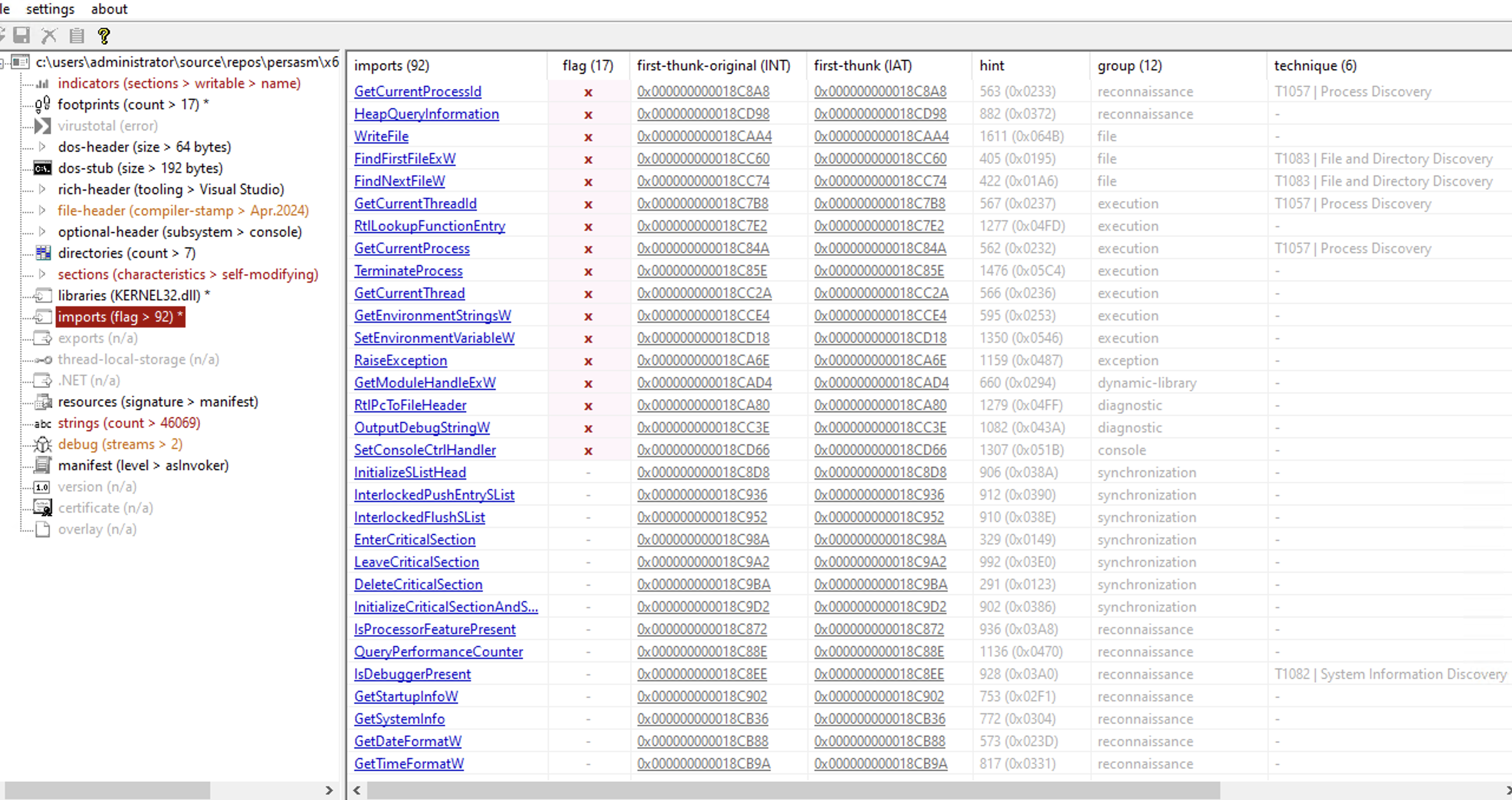
Even though we don’t directly call any KERNEL32.dll functions in our x64 MASM assembly code or in our C++ code, its likely the compiler added these entries in at compilation time. Playing around with different compilers and their options could allow us to reduce some such imports but probably not all imports as these listed function APIs are used the PE’s CRT (C runtime) library e.g ucrt or msvcrt in functions referenced by the startup or essential runtime code which is linked into every executable by default.
It is possible to compile PE’s without a CRT but we would lose access to common functionality offered by it. Perhaps it is possible to implement all required functions in x64 MASM assembly or resolve these with our custom GetBase and resolveFunc assembly functions, but this would require further exploring.
This blog shows how you might try to reduce IAT compiler or CRT imports with Visual Studio C++ compilations, but potentially at the cost of your code no longer working. It is worth playing around with settings, you might eventually achieve some good results:
In VS Project Settings - we can do things like:
C/C++ -> Code Generation- Change Runtime Library to/MT(Static Linking)Linker->Input- Disable DefaultLibsC/C++ -> Code Generation- Disable Security ChecksC/C++>All Options>Basic Runtime Checks- Disable Basic Runtime Checks by settingDefaultLinker->Advanced- Set Entrypoint e.gmain
Trying these on our code would give us an error as we are not resolving printf which is defined in CRT (C Runtime) 
If we wanted we could implement our own printf function, attempt to resolve it with our custom GetBase and resolveFunction assembly functions or perhaps find some way achieving minimal linking with compiler options. However, if we perform the above modifications and remove our references of usage of printf and stdio.h from our code completely, we notice that if we debug in VS the code still works and the resulting PE has NO imports whatsoever.
Whether this is a pro or con, will need to be determined. As we need to consider that having no IAT entries could be more suspicious than having some common CRT ones. Researching this will be an exercise left to the reader. 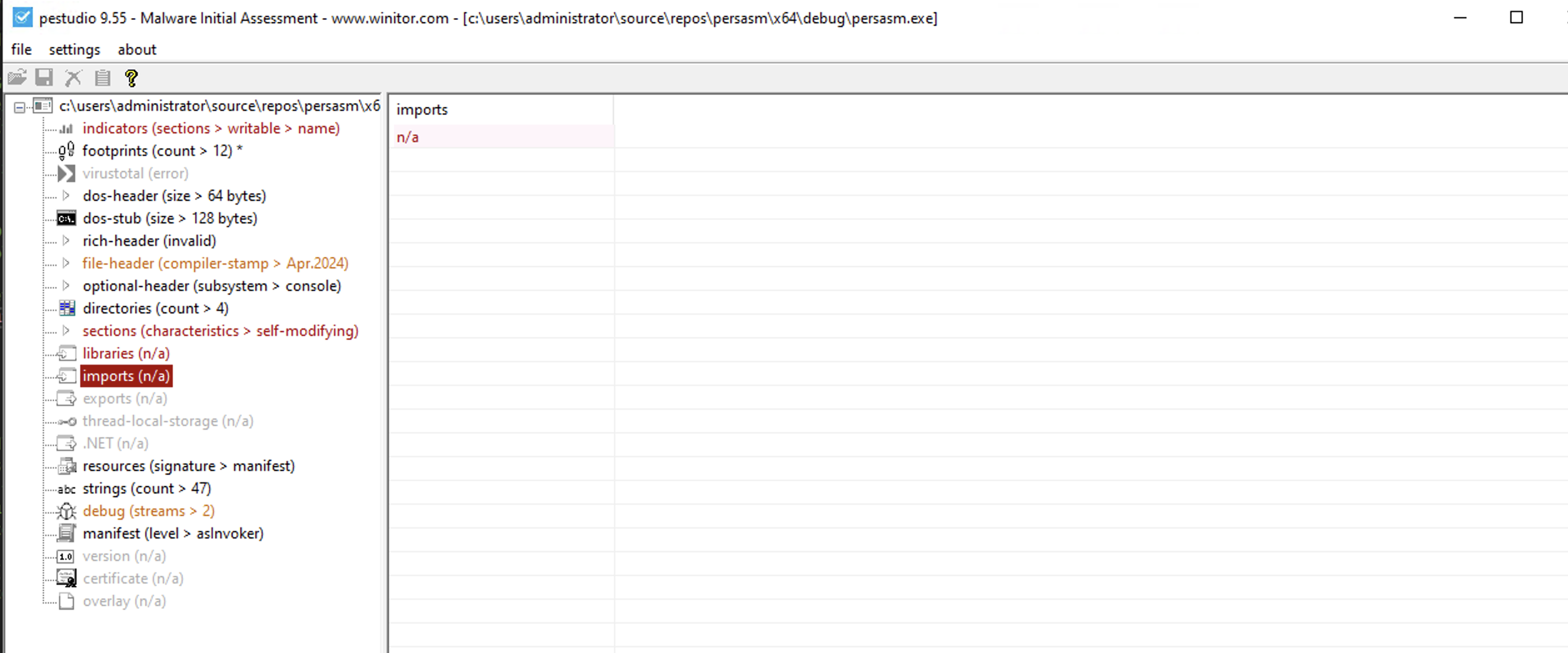
MinGW We can explore results offered by other compilers, let us consider the MinGW for Windows compiler. I installed it via Chocolatey with the help of this blog.
1
choco install mingw
We can assemble an object file with the x64 MASM assembly like so in x64 Native Tools for VS command prompt:
1
ml64 /c /Fo asm.obj test.asm
Then with MinGW for Windows create an object file for our C++ code, and finally link both together to produce an EXE:
1
2
g++ -m64 -c PersASM.cpp -o PersASM.o
g++ -o MinGWPersASM.exe PersASM.o asm.obj
We see the overall IAT entries number is significantly less in our PE than with Visual Studio compilations (34 less entries): 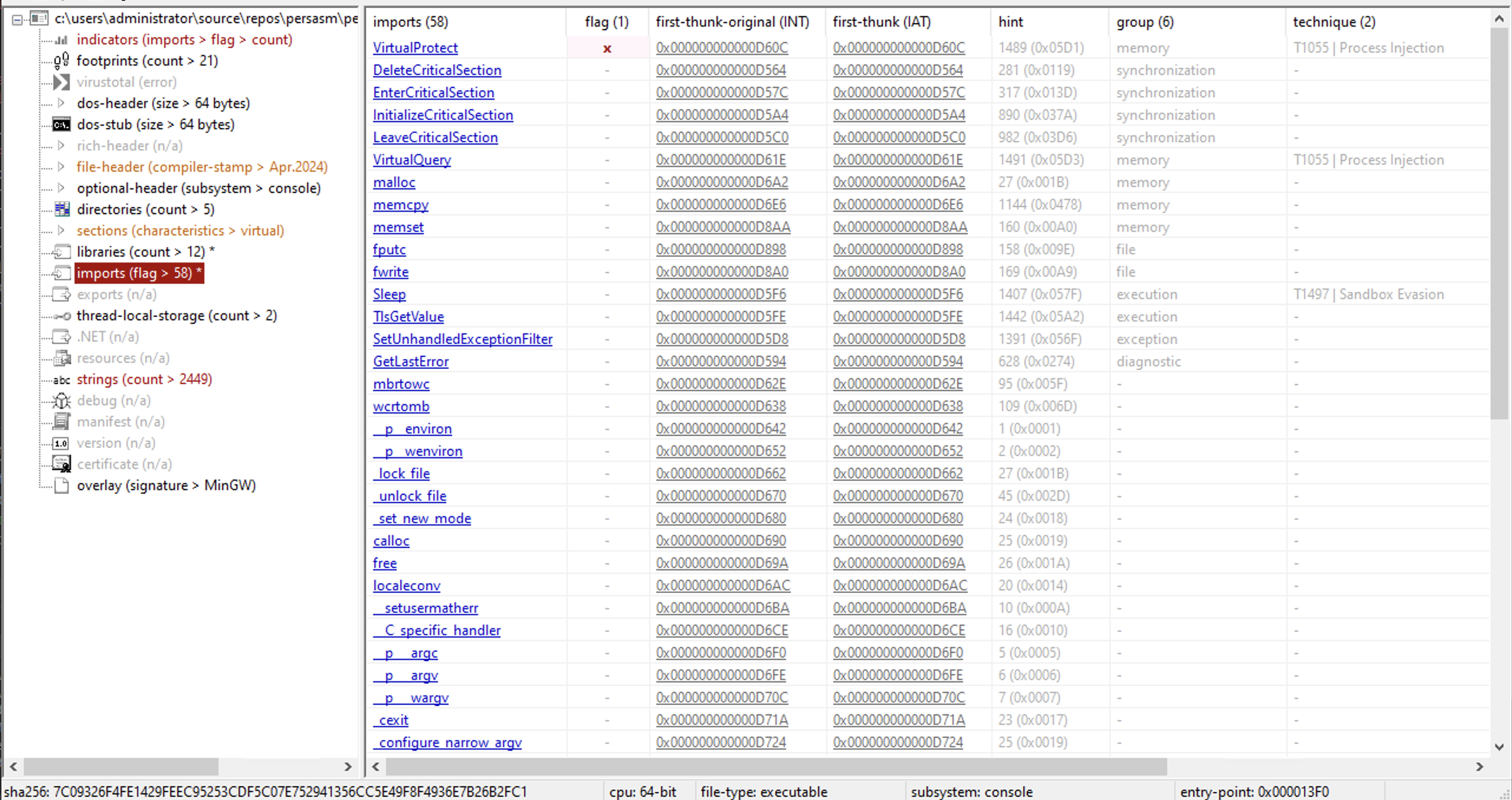
This appears already better than the default PE created by the Visual Studio 2022 compiler. But the MinGW g++ compiler or it’s CRT, imports this one semi-suspicious KERNEL32.dll function - VirtualProtect.
LLVM/CLANG Lets look at LLVM/CLANG for Windows.
1
choco install llvm
Then compiled an object file with the x64 MASM assembly like so in x64 Native Tools for VS command prompt:
1
ml64 /c /Fo asm.obj test.asm
And then also with LLVM/Clang for Windows compiled an object from the c++ code, and finally produced the EXE:
1
2
clang++ -m64 -c .\PersASM.cpp -o .\PersASM.o
clang++ -m64 .\PersASM.o .\asm.obj -o ClangPersASM.exe -v -nostdlib -lmsvcrt -nostartfiles
There is no VirtualProtect IAT entry as with MinGW, but we do have even less IAT entries overall with LLVM/Clang. Based on PEStudio’s output, there are also slight suspicions on our IAT entries for GetCurrentProcessId, GetCurrentThreadId and RtlLookupFunctionEntry.
We have explored the PE files outputted by various compilation techniques, and have seen how different compilers impact our IAT entries and we even briefly explored how we could achieve NO IAT entries at all. Ultimately, apart from the compiler additions to the IAT table we still have the ability to mask suspicious function usage with our custom GetBase and resolveFunc assembly functions.
Conclusion
So let’s recap what was covered in the Flying Under the Radar series - Part 1:
- We covered Windows structures specific to processes e.g PEB
- We covered in detail how to access process loaded modules and resolve their functions via PEB
- Lastly we also performed some analysis on the outputted PE’s based on various Windows compilers
Next, let’s discuss Indirect Syscalls and their benefits. And discuss the opportunity to potentially make them better.
Hopefully you enjoyed the blog or have gained some ideas of you own as to how you can improve your malware development process, and defeat Static & Dynamic Analysis. Don’t hesitate to reach out to me if you have any feedback.

